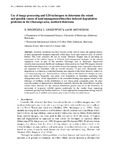| dc.contributor.author | Ringrose, S. | |
| dc.contributor.author | Vanderpost, C. | |
| dc.contributor.author | Matheson, W. | |
| dc.date.accessioned | 2008-07-24T11:29:30Z | |
| dc.date.available | 2008-07-24T11:29:30Z | |
| dc.date.issued | 1997 | |
| dc.identifier.citation | Ringrose, S. et al (1997) Use of image processing and GIS techniques to determine the extent and possible causes of land management/fenceline induced degradation problems in the Okavango area, northern Botswana, International Journal of Remote Sensing Vol. 18, No. 11, pp. 2337-2364 | en |
| dc.identifier.issn | 0143-1160 | |
| dc.identifier.issn | 1366-5901 [online] | |
| dc.identifier.uri | http://hdl.handle.net/10311/173 | |
| dc.description.abstract | Attention worldwide has been focused on the need to assess the appropriateness of land management strategies especially where these occur near sensitive areas of wildlife habitat. This work considers the use of mainly Thematic Mapper data in providing an assessment of the relative impact of different land management strategies on the natural vegetation cover in part of the sensitive Okavango area in Botswana. Supervised classification (maximum likelihood) techniques when used on six-band TM imagery showed that differential degradation was prevalent in land management areas, especially where these are separated by fencelines with an overall accuracy 72 per cent. Marginally more degradation is evident in a controlled hunting area adjacent to the Game Reserve, relative to a communal grazing area. Band transform analyses indicate that distinctive changes in cover type and density frequently take place over boundaries or fencelines separating land management areas. Some degradation in the controlled hunting area appears related to the influence of faultlines on the distribution of soil, hence plant community types. In other cases the pattern of degradation is distributed randomly between the Game Reserve and the cordon fence. Reasons for this unusual distribution pattern may lie in the restriction of movement of migratory wildlife species southwards by the cordon fence separating communal grazing from hunting land uses. A more appropriate management strategy may lie in the prediction of wildlife movements, prior to the erection of cordon fences | en |
| dc.language.iso | en | en |
| dc.publisher | Taylor & Francis; http://www.tandf.co.uk/journals/titles/01431161.asp | en |
| dc.subject | Land management strategies | en |
| dc.subject | Fence | en |
| dc.subject | Okavango Delta | en |
| dc.title | Use of image processing and GIS techniques to determine the extent and possible causes of land management/fenceline induced degradation problems in the Okavango area, northern Botswana | en |
| dc.type | Article | en |

